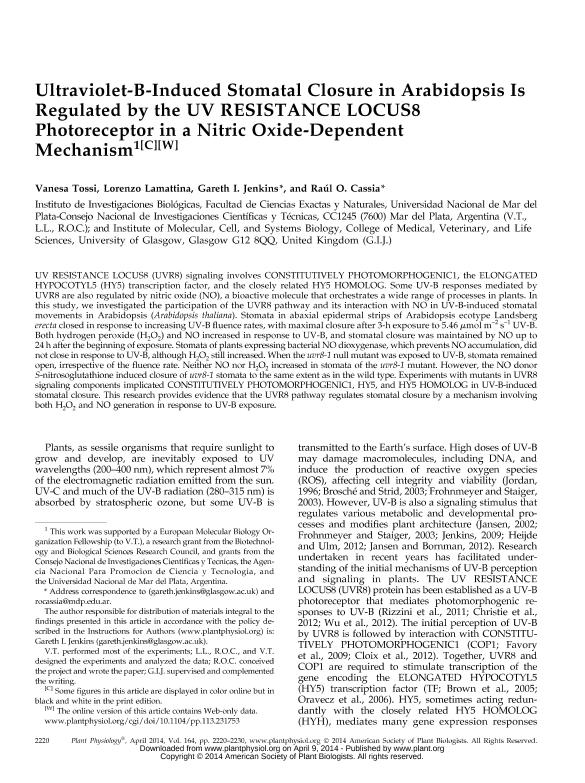Mostrar el registro sencillo del ítem
dc.contributor.author
Tossi, Vanesa Eleonora

dc.contributor.author
Tossi, Vanesa Eleonora

dc.contributor.author
Lamattina, Lorenzo

dc.contributor.author
Lamattina, Lorenzo

dc.contributor.author
Jenkins, Gareth

dc.contributor.author
Jenkins, Gareth

dc.contributor.author
Cassia, Raul Oscar

dc.contributor.author
Cassia, Raul Oscar

dc.date.available
2018-01-24T15:19:50Z
dc.date.issued
2014-02
dc.date.issued
2014-02
dc.identifier.citation
Tossi, Vanesa Eleonora; Lamattina, Lorenzo; Jenkins, Gareth; Cassia, Raul Oscar; Ultraviolet-B-Induced Stomatal Closure in Arabidopsis Is Regulated by the UV RESISTANCE LOCUS8 Photoreceptor in a Nitric Oxide-Dependent Mechanism; American Society of Plant Biologist; Plant Physiology; 164; 4; 2-2014; 2220-2230
dc.identifier.citation
Tossi, Vanesa Eleonora; Lamattina, Lorenzo; Jenkins, Gareth; Cassia, Raul Oscar; Ultraviolet-B-Induced Stomatal Closure in Arabidopsis Is Regulated by the UV RESISTANCE LOCUS8 Photoreceptor in a Nitric Oxide-Dependent Mechanism; American Society of Plant Biologist; Plant Physiology; 164; 4; 2-2014; 2220-2230
dc.identifier.issn
0032-0889
dc.identifier.issn
0032-0889
dc.identifier.uri
http://hdl.handle.net/11336/34394
dc.description.abstract
UV RESISTANCE LOCUS8 (UVR8) signaling involves CONSTITUTIVELY PHOTOMORPHOGENIC1, the ELONGATEDHYPOCOTYL5 (HY5) transcription factor, and the closely related HY5 HOMOLOG. Some UV-B responses mediated byUVR8 are also regulated by nitric oxide (NO), a bioactive molecule that orchestrates a wide range of processes in plants. Inthis study, we investigated the participation of the UVR8 pathway and its interaction with NO in UV-B-induced stomatalmovements in Arabidopsis (Arabidopsis thaliana). Stomata in abaxial epidermal strips of Arabidopsis ecotype Landsbergerectaclosed in response to increasing UV-Bfluence rates, with maximal closure after 3-h exposure to 5.46mmol m–2s–1UV-B.Both hydrogen peroxide (H2O2) and NO increased in response to UV-B, and stomatal closure was maintained by NO up to24 h after the beginning of exposure. Stomata of plants expressing bacterial NO dioxygenase, which prevents NO accumulation, didnot close in response to UV-B, although H2O2still increased. When theuvr8-1null mutant was exposed to UV-B, stomata remainedopen, irrespective of thefluence rate. Neither NO nor H2O2increased in stomata of theuvr8-1mutant. However, the NO donorS-nitrosoglutathione induced closure ofuvr8-1stomata to the same extent as in the wild type. Experiments with mutants in UVR8signaling components implicated CONSTITUTIVELY PHOTOMORPHOGENIC1, HY5, and HY5 HOMOLOG in UV-B-inducedstomatal closure. This research provides evidence that the UVR8 pathway regulates stomatal closure by a mechanism involvingboth H2O2and NO generation in response to UV-B exposure.
dc.description.abstract
UV RESISTANCE LOCUS8 (UVR8) signaling involves CONSTITUTIVELY PHOTOMORPHOGENIC1, the ELONGATEDHYPOCOTYL5 (HY5) transcription factor, and the closely related HY5 HOMOLOG. Some UV-B responses mediated byUVR8 are also regulated by nitric oxide (NO), a bioactive molecule that orchestrates a wide range of processes in plants. Inthis study, we investigated the participation of the UVR8 pathway and its interaction with NO in UV-B-induced stomatalmovements in Arabidopsis (Arabidopsis thaliana). Stomata in abaxial epidermal strips of Arabidopsis ecotype Landsbergerectaclosed in response to increasing UV-Bfluence rates, with maximal closure after 3-h exposure to 5.46mmol m–2s–1UV-B.Both hydrogen peroxide (H2O2) and NO increased in response to UV-B, and stomatal closure was maintained by NO up to24 h after the beginning of exposure. Stomata of plants expressing bacterial NO dioxygenase, which prevents NO accumulation, didnot close in response to UV-B, although H2O2still increased. When theuvr8-1null mutant was exposed to UV-B, stomata remainedopen, irrespective of thefluence rate. Neither NO nor H2O2increased in stomata of theuvr8-1mutant. However, the NO donorS-nitrosoglutathione induced closure ofuvr8-1stomata to the same extent as in the wild type. Experiments with mutants in UVR8signaling components implicated CONSTITUTIVELY PHOTOMORPHOGENIC1, HY5, and HY5 HOMOLOG in UV-B-inducedstomatal closure. This research provides evidence that the UVR8 pathway regulates stomatal closure by a mechanism involvingboth H2O2and NO generation in response to UV-B exposure.
dc.format
application/pdf
dc.format
application/pdf
dc.language.iso
eng
dc.language.iso
eng
dc.publisher
American Society of Plant Biologist

dc.publisher
American Society of Plant Biologist

dc.rights
info:eu-repo/semantics/openAccess
dc.rights.uri
https://creativecommons.org/licenses/by-nc-sa/2.5/ar/
dc.subject
Photomorphogenic1
dc.subject
Photomorphogenic1
dc.subject
Hy5 Homolog
dc.subject
Hy5 Homolog
dc.subject
Nitric Oxide
dc.subject
Nitric Oxide
dc.subject.classification
Otras Ciencias Biológicas

dc.subject.classification
Otras Ciencias Biológicas

dc.subject.classification
Ciencias Biológicas

dc.subject.classification
Ciencias Biológicas

dc.subject.classification
CIENCIAS NATURALES Y EXACTAS

dc.subject.classification
CIENCIAS NATURALES Y EXACTAS

dc.title
Ultraviolet-B-Induced Stomatal Closure in Arabidopsis Is Regulated by the UV RESISTANCE LOCUS8 Photoreceptor in a Nitric Oxide-Dependent Mechanism
dc.title
Ultraviolet-B-Induced Stomatal Closure in Arabidopsis Is Regulated by the UV RESISTANCE LOCUS8 Photoreceptor in a Nitric Oxide-Dependent Mechanism
dc.type
info:eu-repo/semantics/article
dc.type
info:ar-repo/semantics/artículo
dc.type
info:eu-repo/semantics/publishedVersion
dc.date.updated
2018-01-24T14:55:56Z
dc.journal.volume
164
dc.journal.volume
164
dc.journal.number
4
dc.journal.number
4
dc.journal.pagination
2220-2230
dc.journal.pagination
2220-2230
dc.journal.pais
Estados Unidos

dc.journal.pais
Estados Unidos

dc.journal.ciudad
Rockville
dc.journal.ciudad
Rockville
dc.description.fil
Fil: Tossi, Vanesa Eleonora. Consejo Nacional de Investigaciones Científicas y Técnicas. Centro Científico Tecnológico Conicet - Mar del Plata. Instituto de Investigaciones Biológicas. Universidad Nacional de Mar del Plata. Facultad de Ciencias Exactas y Naturales. Instituto de Investigaciones Biológicas; Argentina
dc.description.fil
Fil: Tossi, Vanesa Eleonora. Consejo Nacional de Investigaciones Científicas y Técnicas. Centro Científico Tecnológico Conicet - Mar del Plata. Instituto de Investigaciones Biológicas. Universidad Nacional de Mar del Plata. Facultad de Ciencias Exactas y Naturales. Instituto de Investigaciones Biológicas; Argentina
dc.description.fil
Fil: Lamattina, Lorenzo. Consejo Nacional de Investigaciones Científicas y Técnicas. Centro Científico Tecnológico Conicet - Mar del Plata. Instituto de Investigaciones Biológicas. Universidad Nacional de Mar del Plata. Facultad de Ciencias Exactas y Naturales. Instituto de Investigaciones Biológicas; Argentina
dc.description.fil
Fil: Lamattina, Lorenzo. Consejo Nacional de Investigaciones Científicas y Técnicas. Centro Científico Tecnológico Conicet - Mar del Plata. Instituto de Investigaciones Biológicas. Universidad Nacional de Mar del Plata. Facultad de Ciencias Exactas y Naturales. Instituto de Investigaciones Biológicas; Argentina
dc.description.fil
Fil: Jenkins, Gareth. University of Glasgow; Reino Unido
dc.description.fil
Fil: Jenkins, Gareth. University of Glasgow; Reino Unido
dc.description.fil
Fil: Cassia, Raul Oscar. Consejo Nacional de Investigaciones Científicas y Técnicas. Centro Científico Tecnológico Conicet - Mar del Plata. Instituto de Investigaciones Biológicas. Universidad Nacional de Mar del Plata. Facultad de Ciencias Exactas y Naturales. Instituto de Investigaciones Biológicas; Argentina
dc.description.fil
Fil: Cassia, Raul Oscar. Consejo Nacional de Investigaciones Científicas y Técnicas. Centro Científico Tecnológico Conicet - Mar del Plata. Instituto de Investigaciones Biológicas. Universidad Nacional de Mar del Plata. Facultad de Ciencias Exactas y Naturales. Instituto de Investigaciones Biológicas; Argentina
dc.journal.title
Plant Physiology

dc.journal.title
Plant Physiology

dc.relation.alternativeid
info:eu-repo/semantics/altIdentifier/doi/http://dx.doi.org/10.1104/pp.113.231753
dc.relation.alternativeid
info:eu-repo/semantics/altIdentifier/doi/http://dx.doi.org/10.1104/pp.113.231753
dc.relation.alternativeid
info:eu-repo/semantics/altIdentifier/url/http://www.plantphysiol.org/content/164/4/2220
dc.relation.alternativeid
info:eu-repo/semantics/altIdentifier/url/http://www.plantphysiol.org/content/164/4/2220
Archivos asociados
